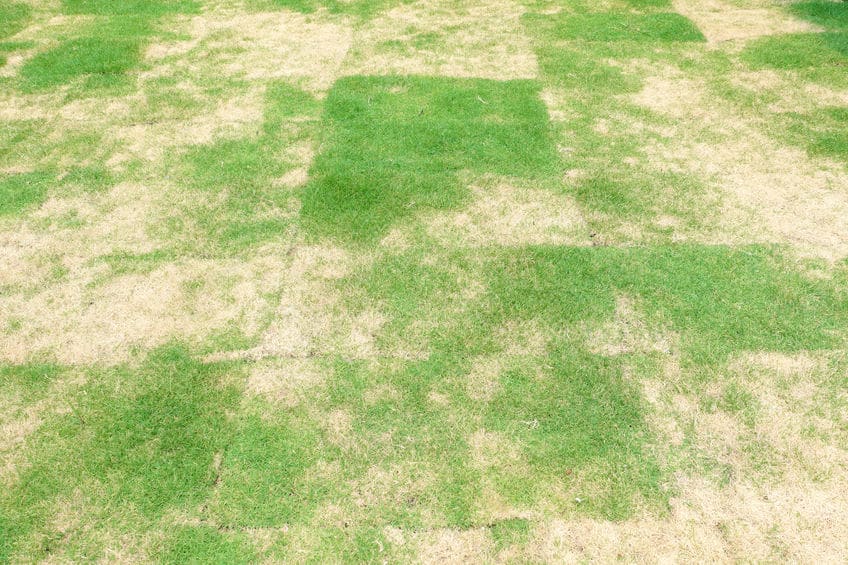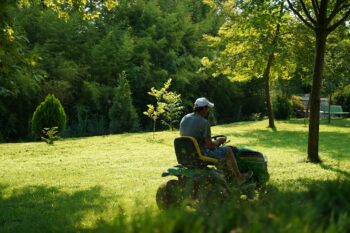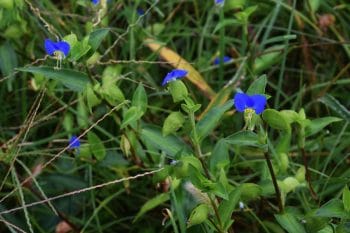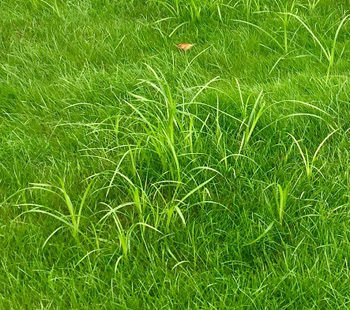Combating lawn disease is a task every homeowner will face sooner or later, if not multiple times throughout the life of their lawn. This is certainly not a one-size-fits-all issue to contend with, as each disease has its own causes and remedies.
In this new article series, we’re going to break down the 10 most common lawn diseases here in Texas, both broadly and specifically. For this particular piece, we will provide an overview of each disease, giving you a basic idea about what to look for and how to proceed.
Be on the lookout for additional articles that take a closer look at each lawn condition, providing more details about how to handle and prevent them to keep your yard healthy!
Leaf Spot Disease
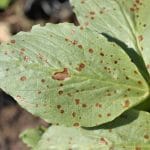 While leaf spot disease is commonly seen in the leaves of trees and shrubs, it can also affect Bermuda grass, bluegrass, ryegrass, and tall fescue. Most North Texas lawns include warm-season grasses, so the main threat for leaf spot disease is extended periods of cool temperature, along with dry soil. Compacted soil that needs aerating creates an even more welcoming environment for this fungus to spread.
While leaf spot disease is commonly seen in the leaves of trees and shrubs, it can also affect Bermuda grass, bluegrass, ryegrass, and tall fescue. Most North Texas lawns include warm-season grasses, so the main threat for leaf spot disease is extended periods of cool temperature, along with dry soil. Compacted soil that needs aerating creates an even more welcoming environment for this fungus to spread.
Additionally, excessive nitrogen levels in the soil can help feed leaf spot disease. Add to that a spell of high humidity, and you’ve got the perfect storm for this foe to take over your yard.
With this disease, what you’ll see is elongated brown spots on your grass blades, often with deep brown or purple outlines. The roots and crowns of the grass will begin to rot as well. Left unchecked, the health of your entire yard can be jeopardized.
Gray Leaf Spot Disease
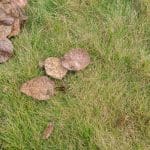 Much like its counterpart, this disease prefers rye grass and tall fescues, but St. Augustine grass is also at risk. Again, high humidity, compacted soil, and too much nitrogen can contribute to the cause.
Much like its counterpart, this disease prefers rye grass and tall fescues, but St. Augustine grass is also at risk. Again, high humidity, compacted soil, and too much nitrogen can contribute to the cause.
Gray leaf spot disease can also thrive in areas that receive extensive shade. Unlike “regular” leaf spot disease, this one actually propagates well in excessive heat.
This disease can be identified by the “blanched” spots it creates in your grass blades, typically with dark brown edges. It gets is name from the fact that the spots can appear gray and fuzzy whenever they are wet.
Learn more about leaf spot and gray leaf spot diseases here.
Dollar Spot Lawn Disease
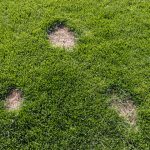 This disease largely affects rye grasses, fescue, Zoysia grass, and Bermuda grass. It gets its name from the silver dollar-sized spots that indicate the beginnings of an infection. But don’t let that term fool you; these spots can grow into much larger patches of ailing grass.
This disease largely affects rye grasses, fescue, Zoysia grass, and Bermuda grass. It gets its name from the silver dollar-sized spots that indicate the beginnings of an infection. But don’t let that term fool you; these spots can grow into much larger patches of ailing grass.
With dollar spot, your grass’s blades will appear yellow, wet, and wilted. Sometimes the web-like pattern of fungus can be noted in the light of early morning. It tends to propagate in the mild warmth of late spring and early fall.
As with many lawn diseases, excessive thatch and moisture buildup make your lawn more vulnerable to this disease. However, unlike some of its counterparts, dollar spot is more likely to crop up in under-fertilized lawns. This is why striking a good balance of minerals is critical to avoiding fungal diseases in general.
Learn more about dollar spot disease.
Red Thread Lawn Disease
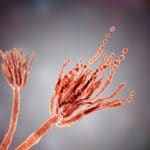 This fungal infection spreads in rye grasses, fescues, and bluegrasses. If you’ve cultivated a turf of mixed grasses in your yard, it may be susceptible to red thread disease
This fungal infection spreads in rye grasses, fescues, and bluegrasses. If you’ve cultivated a turf of mixed grasses in your yard, it may be susceptible to red thread disease
Despite the name, this disease can cause your grass blades to appear either reddish or yellowish-white. It infects the blades beginning at the tips, making it fairly easily to identify. The main problem with red thread disease is that it spreads very easily throughout your lawn, as the tiny spores adhere to shoes and lawn equipment.
Red thread loves thick thatch, high humidity, and compacted soil. Look out for low areas in your lawn, especially in the shade, and be sure to fertilize adequately. Let us know if you need professional help with dethatching and aerating your lawn.
Learn more about red thread disease here.
Rust Lawn Disease
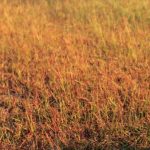 Rust lawn disease is most likely to damage fescues, Zoysia grass, and perennial rye grasses. It begins with small yellowish spots on the blades, which will eventually turn orange-brown like the color of rust.
Rust lawn disease is most likely to damage fescues, Zoysia grass, and perennial rye grasses. It begins with small yellowish spots on the blades, which will eventually turn orange-brown like the color of rust.
It can be difficult to identify this infection in the beginning, as the growth pattern tends to be less patchy than most other diseases. What you’ll see is small clumps of wilting grass that are partially discolored but may still retain some green in the shafts.
Rust lawn disease prefers both drought and high humidity, thriving in both excessive moisture and excessive shade. Basically, any conditions that will have your lawn already stressed out will leave it more vulnerable. This is yet another fungus that enjoys an over-fertilized yard.
Learn more about red thread and rust lawn diseases.
Pythium Lawn Disease
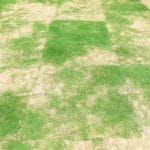 Bluegrasses, fescue, and rye grasses are most susceptible to pythium lawn disease, so your North Texas turf may be safe from this foe. However, it moves quickly in its brownish-black path of destruction, so it’s good to know how to identify it.
Bluegrasses, fescue, and rye grasses are most susceptible to pythium lawn disease, so your North Texas turf may be safe from this foe. However, it moves quickly in its brownish-black path of destruction, so it’s good to know how to identify it.
Pythium lawn disease loves an overwatered lawn, and the diseased spots tend to crop up along the path of water flow throughout your yard. While the initial yellowing looks much like other diseases, pythium will cause blackened, slimy looking blades with brown, rotting roots. The blades may stick together, and they die rapidly once the fungus takes hold.
Once again, this is a fungus that loves moisture, heat, and shade. It also thrives on over-fertilized lawns, so be on the lookout after a nitrogen treatment, especially during humid weather. Ryno Lawn Care can help you achieve a balanced fertilization schedule.
Learn more about pythium lawn disease here.
Large Patch Lawn Disease
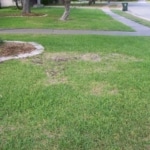 This particular fungus really loves warm-season grasses, so St. Augustine, Zoysia grass, and Bermuda grass are especially susceptible. While this fungus is always present in your lawn, it can create large, erratic patches of yellowing grass under the right conditions.
This particular fungus really loves warm-season grasses, so St. Augustine, Zoysia grass, and Bermuda grass are especially susceptible. While this fungus is always present in your lawn, it can create large, erratic patches of yellowing grass under the right conditions.
And by “right conditions,” of course we mean the wrong conditions. This would include cool spring and fall weather that includes excessive moisture. Large patch loves a good layer of thatch to propagate in, so aerating your lawn is an effective preventative measure.
This disease can be distinguished from its close cousin, brown patch, by the weather and by the growth pattern. Large patch is less likely to turn your grass brown, and brown patch is more likely to crop up in warmer weather.
Learn more here about the difference between large patch and brown patch disease.
Brown Patch Lawn Disease
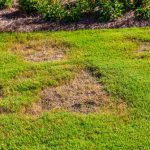 This fungal disease tends to infect Bermuda grass, St Augustine, fescue, and perennial rye grass. While it does cause brown patches, as the name implies, the infection begins with large patches of yellowing blades. They may appear sunken and wilted, sometimes with a small area of still-healthy grass in the center.
This fungal disease tends to infect Bermuda grass, St Augustine, fescue, and perennial rye grass. While it does cause brown patches, as the name implies, the infection begins with large patches of yellowing blades. They may appear sunken and wilted, sometimes with a small area of still-healthy grass in the center.
As the disease progresses, the blades will turn brownish and begin to die. Patches may reach an area of 3 feet in diameter. The outer edges often turn greyish, making this disease distinguishable from similar fungal infections.
Brown patch lawn disease favors hot and humid weather, making it a legitimate threat in North Texas spring and summertime. Beware of overwatering and over-fertilizing, and pay attention to any low spots in your lawn where moisture can accumulate.
Learn more about brown patch here.
Summer Patch Lawn Disease
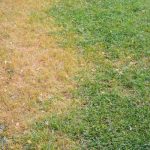 Summer patch lawn disease is named for the fact that it prefers high temperatures in the spring and summer. It tends to affect fescue, bluegrass, and perennial rye grass. Once again, excessive moisture with compacted soil gives this disease a ripe environment for growth.
Summer patch lawn disease is named for the fact that it prefers high temperatures in the spring and summer. It tends to affect fescue, bluegrass, and perennial rye grass. Once again, excessive moisture with compacted soil gives this disease a ripe environment for growth.
This disease tends to create a “halo” of sickness around a patch of otherwise healthy-looking grass blades. You may see a circle of ailing yellowish grass, even though the blades within don’t appear to be distressed. Upon closer inspection, brown threads of fungus can be seen among the stolons and rhizomes just along the ground’s surface.
Summer patch disease thrives in excessive moisture and poor drainage, so be mindful of overwatering as well as low spots in your terrain. As with most others, it also prefers excessive thatch and compacted soil. Mowing too short or too frequently can also contribute to the problem.
Learn more about summer patch disease here.
Snow Mold Lawn Disease
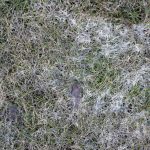 While the North Texas Region doesn’t get a lot of snow, this disease is still a potential threat due to the occasional winter freeze. It tends to affect bluegrass, rye grass, and fescue, so be on the lookout if you’ve chosen to propagate a mixed turf on your lawn.
While the North Texas Region doesn’t get a lot of snow, this disease is still a potential threat due to the occasional winter freeze. It tends to affect bluegrass, rye grass, and fescue, so be on the lookout if you’ve chosen to propagate a mixed turf on your lawn.
As the name implies, snow mold disease develops as a result of the damage caused both by frost and by the subsequent thawing, leaving the blades vulnerable to disease. The microbes which then feast on the dying foliage are actual fungi, however, rather than mold. It begins with pinkish spots in your lawn, which later turn reddish or brown. Fully dead grass spots will appear tan with a webbing of fungal growth.
Snow mold prefers cold, wet temperatures and a lot of shade. If you’ve done a nitrogen treatment in the fall, and later face an early frost, be sure to check the areas of your lawn that tend to accumulate more water.
Learn more here about snow mold lawn disease.

